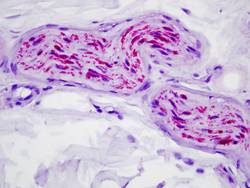Pruritus is an autonomous sensation in the skin and arises independently from what we perceive as pain. Superficial nerve endings in the skin react to many different kinds of messenger chemicals from the skin and blood, causing itch to develop. Itch-related sensations such as pure itching, stinging or burning itch and painful tingling, can be explained by these various chemicals. These sensations are transported from nerves in the spinal cord to the brain, where the immediate need to scratch is triggered. Pruritus can have many causes.
Acute pruritus is an important warning function. It indicates the presence of foreign bodies such as insects, parasites or harmful plant components (e.g. nettles) that can be eliminated through scratching. Acute itching is usually a healthy reaction to threatening stimuli that disappears quickly and is easily treated.
Chronic pruritus is persistent itching and, in most cases, difficult to treat. It often leads to severe physical and emotional distress. Possible causes include liver and kidney disorders, vitamin deficiency, diabetes, thyroid disorders, or more rarely, a malignant disease. Many skin diseases result in insufferable itching. This itching may even be present before the disease is visible or in full force. Pruritus is considered chronic when it persists longer than 6 weeks. If you have had chronic itching for longer than 6 weeks, now is the time to seek a diagnosis.
Due to its many possible causes, pruritus is thus an “interdisciplinary symptom,” in that a cause is best identified through a collaboration of experts in different fields (dermatologists, internal medicine specialists, neurologists, radiologists, psychosomaticists, gynecologists, pediatricians, etc.). This expert collaboration is the basis of patient care in the Center for Chronic Pruritus.


